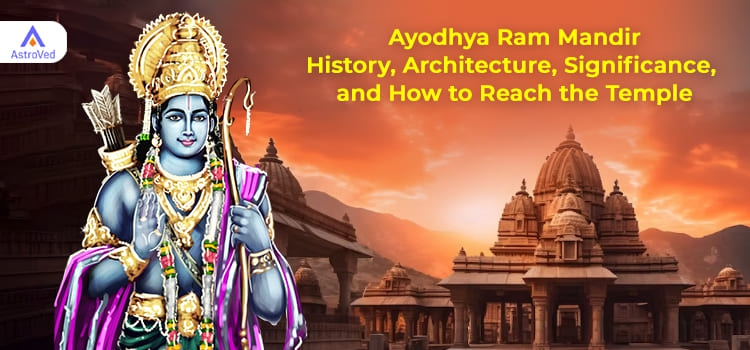Ayodhya Ram Mandir: History, Architecture, Significance, and How to Reach the Temple
History of the Ayodhya Ram Mandir
Lord Rama, the 7th avatar of Vishnu, one of the Trimurti in Hinduism, is believed to have been born in Ayodhya, which lies in the state of Uttar Pradesh, India. Hence, Ayodhya is also called Ram Janmabhoomi. This place is very holy for Hindus as Rama is a highly revered deity, who is also called Maryada Purushottam or the ideal man. His story is told in the epic Ramayana, written by Maharishi Valmiki.
Hindus believe that many centuries ago, there was a temple for Rama in his birthplace. Here, devotees worshipped Rama in his child form, Ram Lalla. However, the Mughals destroyed this temple, and a mosque came up in the same location. This was the Babri Masjid mosque.
Excavations carried out at the site in 1976-77 revealed the remains of an ancient and grand Hindu temple beneath the Babri mosque. Twelve pillars of the Babri mosque, which was under police custody at the time, were made from the remains of the temple, says K.K. Muhammad, one of the members of the ASI (Archeological Survey of India) team that carried out the excavation. Many such mosques in India in fact were built using the spoils of Hindu temples. This is a historical fact.
Some people contested the discovery of the temple remains, so another excavation took place in 2003, by which time the mosque had been destroyed. In 1992, a rampaging Hindu mob of kar sevaks demolished the mosque, leading to widespread riots and communal tensions. The second excavation revealed that a very large and imposing structure had existed once. The team found more than 50 pillar bases in 17 rows. The structure dates back to the 12th century AD. As terracotta objects depicting living beings like animals and also gods and goddesses were found in the ruins, it was clear that they belonged to a temple and not a mosque, as Islam does not allow such depictions.
Also, the archeologists discovered two pieces of a Vishnu Hari Sheela Phalak inscription in the ruins. The evidence suggested that the temple had associations with an avatar of Vishnu who had slain Bali and a 10-headed person.

Literary evidence, too, points to the existence of a Hindu temple. In Ain-e-Akbari Volume III, Abu Fazl states that Hindus worshipped Ayodhya in the month of Chaitra. In his travelogue, the traveler, William Finch, a British merchant who visited India during Jahangir’s time and explored many cities in India, says that many people gathered at this place in Ayodhya to offer worship. He was witness to the location of Ramkot or "Rama's fort" (site of the present-day Ayodhya). He described ruins that he thought were Rama's palace and houses. The palace, he said, was 400 years old. In 1766, Jospeh Taissen Thaler mentions the erection of a cradle at this place. In a first, he also observed that Babur or Aurangzeb had destroyed the temple.
Supreme Court Verdict
The first police complaint in the Ayodhya dispute was in 1858, and the first cases were filed in 1885. However, the movement for Ram Mandir got a huge thrust in 1989 when the Vishva Hindu Parishad (VHP) laid a foundation stone ('shilanyas') at the disputed site.
In September 1990, BJP leader, LK Advani, began a Rath Yatra from Gujarat's Somnath to Ayodhya in Uttar Pradesh to create awareness about the Ram Janmabhoomi issue and to raise support for building a Ram Mandir in Ayodhya. It led to communal tensions, and in December 1992, kar sevaks climbed the Babri Masjid mosque and demolished it.
Hindus and Muslim litigants fought a prolonged court battle to claim the disputed site, and finally, the Supreme Court delivered a verdict in 2019 allowing temple construction at the site. Muslim litigants got a 5-acre plot of land to build a mosque elsewhere in Ayodhya as compensation.
Once the dispute ended, the temple construction began. The inauguration of the Ram Mandir temple will be on January 22, 2024, by Prime Minister Narendra Modi in the presence of spiritual leaders and other eminent personalities.
Modi also performed the bhumi pujan ceremony for commencing the construction on 5 August 2020.
Architecture of the Ayodhya Ram Mandir
The Ram temple’s original design was conceived in 1988 by the Sompuras, who are famous architects from Ahmedabad. They have been designing temples for 15 generations. Over 100 temples all over the world bear their imprint. This includes the iconic Somnath temple. Its chief architect was Chandrakant Sompura, and his architect sons Nikhil and Ashish assisted him.
The Sompuras came up with a fresh design, aligned with Vaastu Shastra and the Shilpa Shastras. The revised blueprint included some changes while maintaining the temple’s traditional features. The Sompuras unveiled this design in 2019 during the Prayag Kumbh Mela.
The temple will be 235 ft wide, 360 ft in length, and 161 feet high. It will be the world’s third-largest Hindu shrine when completed. It features the Gujara-Chaulukya style of Northern Indian temple architecture.
The main structure will stand at an elevation on a raised platform. It will have 3 stories, with 5 mandapas in the garbhagriha and entryway. As per the Nagara style, shikharas will adorn the mandapas. There will be a total of 366 columns, and 16 idols that represent various deities will adorn each column.
The temple complex will cover 10 acres and extend beyond the main shrine. A prayer hall, lecture hall, a museum, educational facilities, and a cafeteria, with a total of 57 developed acres will be part of the complex. The temple can accommodate over 70,000 visitors.
600,000 cu ft of sandstone from Baansi, Rajasthan, will be used to construct the Ram Mandir. 10, 000 copper plates will be used to fuse the stone blocks. Thailand will send soil as a symbolic contribution. It had also sent water from two rivers in Thailand earlier.
Rama’s infant form, Ram Lalla Virajman, will be the presiding deity of the temple. The temple will also have shrines for Surya, Ganesha, Shiva, Durga, Vishnu, and Brahma. The sanctum will have 2 idols of Ram Lalla.
The creator of Ram’s idol is Karnataka-based sculptor Arun Yogiraj.
Consecration Ceremony
The consecration ceremony of the temple will be at 12:20 pm IST on 22 January 2024. Spiritual leaders, sports personalities, celebrities, and businesspersons will grace the occasion.
Hindu mythology says that Rama was born during a confluence of Abhijit Muhurat, Mrigashirsha Nakshatra, Amrit Siddhi Yoga, and Sarvartha Siddhi Yoga. On 22 January 2024, all these factors will align; hence, it is the most auspicious date for Pran Pratishtha (consecration ceremony).
Significance of Ram Janmabhoomi Temple
It has been a long-cherished dream of Hindus to have a grand temple for their beloved deity, Lord Rama, in his birthplace, Ayodhya. Ayodhya is holy ground for Hindus, as Ram was born here. Moreover, he is the avatar of Vishnu. Hence, to rebuild the Ram temple in Ayodhya, where people worshipped him in ancient times, has been a highly emotive issue for the Hindu community.
The new Ram Mandir will symbolize the triumphant return of Rama to Ayodhya after centuries of exile following the Mughal invasion. It means many things to many people. It means a validation of faith for devotees. For the people of Ayodhya, it means brighter days ahead, as the temple will attract tourists from all over India and the world, giving a boost to the economy. It will also burnish the image of the city as a renowned pilgrimage destination due to the vastly improved infrastructure and other facilities. There is no doubt that the Ram Mandir will put Ayodhya on the world map.
How to Reach Ram Mandir?
By Air
There are flights to Ayodhya from Lucknow and Varanasi.
By Train
There are trains from major cities in India to Ayodhya. Ayodhya Junction is the main railway station in the city.
By Road
Ayodhya has a well-developed road network. Many state-run and private buses connect Ayodhya to major cities and towns.



















